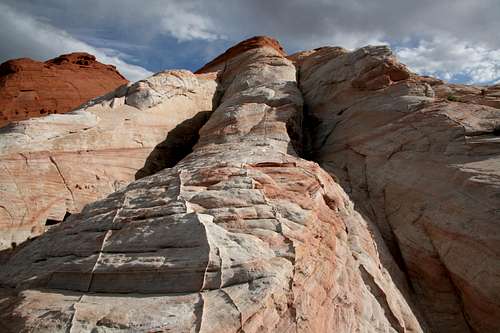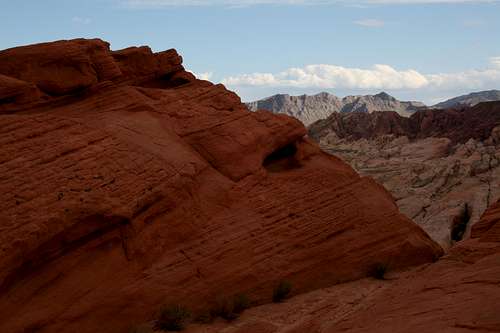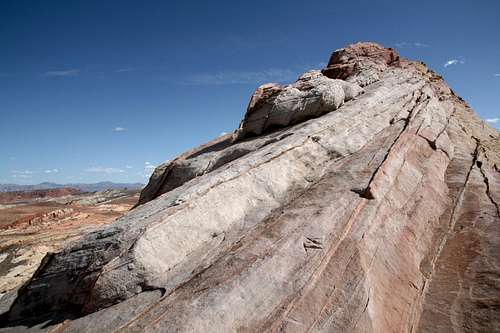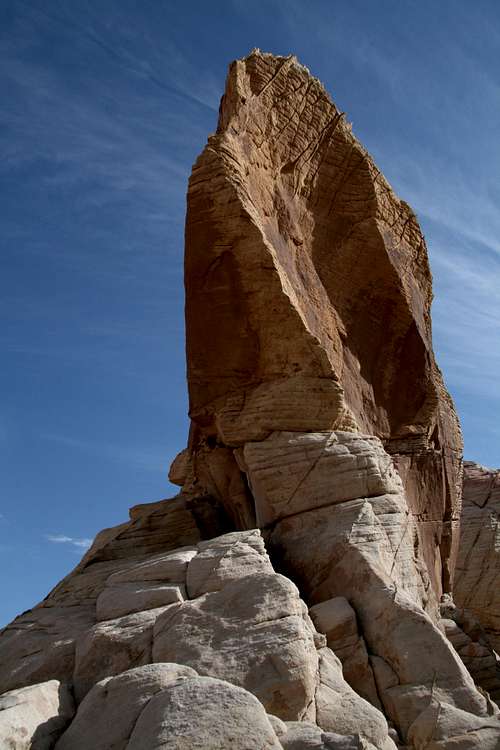-
 7178 Hits
7178 Hits
-
 87.76% Score
87.76% Score
-
 25 Votes
25 Votes
|
|
Mountain/Rock |
|---|---|
|
|
36.48471°N / 114.53184°W |
|
|
Scrambling |
|
|
Spring, Fall, Winter |
|
|
2234 ft / 681 m |
|
|
Overview
Nevada’s Valley of Fire State Park, both the oldest and the largest in the state, is a wonderland of sandstone pinnacles, buttes, domes, and walls that offer a lifetime’s worth of exploring, scrambling, and bouldering in a remote, spectacular setting (the park also seems to hold a lot of potential for technical rock climbing, but the climbing is limited to specific areas in the park, and the White Domes are not among them). The park takes its name from the red rocks that characterize much of the terrain. Even in the middle of the day, when much of the desert has a burned-out look that makes for ugly photographs, the formations here still look dramatic.
The White Domes Loop Trail is one of the most popular trails in the park, and in its beginning, it descends south between the two White Domes, both of which dominate the scenery at the White Domes parking area and trailhead. Both peaks are worthy objectives and can be climbed quickly-- 15-20 minutes for each (one-way)-- by experienced scramblers. They make a nice alternative or addition to the popular trail nearby, and the summit views are breathtaking. These peaks will not test your endurance or keep you busy all day, but they are good fun and have some compelling features of their own in addition to the outstanding summit views.
The east peak is a little higher than the west one. A trailhead sign marks it as being 2234’, with the trailhead being at 2001’. (My GPS device gave me a summit altitude of 2458’, but the other measure more closely matches contour lines on USGS topo maps; also, since my GPS device gave me a TH elevation very close to that on the sign, it reinforces my belief that the strong winds up top were affecting barometric pressure enough to throw off accurate readings.) The east peak is also a little easier to climb, although one section makes the route itself have a harder rating. Both peaks are scrambles, not hikes. More details follow in the next two sections.
Do not let the short distances and elevation gains lull you into thinking these peaks are "cake." For most experienced scramblers, these peaks will be "cake," but at the same time, these are the exact kinds of peaks on which statistics are made through the cocky and/or uninitiated (in all honesty, I probably should not have taken my 4-year-old son on the east peak and probably could not have if not for the help of my brothers). Each peak has a challenging pitch (or pitches) and/or exposure that can translate into serious injury or death.
The peaks are also good objectives for kids. In fact, it was through asking here about kid-friendly scrambles in the Vegas area that someone gave me the idea to climb these peaks. The short distances involved greatly diminish (but do not eliminate) the chances of dehydration and burnout, and if there is an injury or other problem, the car and help are close.
Do not, however, let young children climb unattended. This might seem unnecessary to say, but I was astounded at the number of kids 12 and younger who were up on the peaks while completely unsupervised by adults. In one case, the parents were sitting in lawn chairs at the trailhead picnicking while their kids were on the rocks, often out of sight. On the west peak, I had to “rescue” two kids around 12 or 13 who had climbed an exposed Class 4 spot with little trouble but were spooked when it came to downclimbing it. On the east peak, I watched another group of three struggle with downclimbing the “crux” section, and one nearly injured herself when she leapt the last few feet down, hit the ground hard, lost her balance, and started to roll; all the while, the parents socialized in the parking lot below, oblivious to or unconcerned about the real dangers their children were encountering. I am not saying not to take kids up here-- after all, my four-year-old son went up here, with assistance in a few places-- just that any responsible parent should be supervising and ready to help if needed. Playing on boulders and small outcrops, where a fall might mean tears and a bloody lip, while parents lounge nearby is one thing; playing unsupervised on Class 4 terrain, sometimes with serious exposure, is another.
A note on the ratings in the route descriptions: the Class 4 ratings are subjective and based on my experiences with consensus-rated Class 4 pitches. Someone else might think the pitches are a tough Class 3, and yet another might think they are “easy” Class 5. Bottom line-- you judge the pitches based on your comfort level and not on what someone else has told you about them. If you are uncomfortable with what you see, do not climb it simply because I or someone else has said it is “just” Class 4.
East Peak
Viewed from almost any angle, the east peak lives up to its “dome” appellation. Consisting mostly of yellow and white sandstone with a cap of red sandstone, the peak is beautiful to see from all directions, and from the parking area, most of the route up it is visible.
To climb the peak, head from the parking lot onto the sandstone ramps at the base of the peak and clamber up to a relatively flat sandstone area on the north side of the peak. Do not follow the ramps south along the west side of the peak; although I cannot verify it from experience, those ramps seem to cliff out well below the summit area.
Next, you encounter what is the “crux” of the route. There is a headwall about 8-10’ high. You will have to make use of friction and small holds to get up this wall, and this is a Class 4 pitch. There is no significant exposure, though; if you fall, you might injure yourself, but you’re not going to get killed unless you land just right.
If this spot does not work for you, head to the right and find an ascending gully much like a slot canyon. Some Class 4 chimneying or stemming will get you up from here and onto the sandstone ramps above.
Although I did not photograph the gully described above, this picture shows the types of slot-like gullies I mean.
Once above this section, follow the sandstone ramps to the summit. The going is Class 2 with a spot of easy Class 3 here and there. Note the red, honeycombed walls to your left; they are among the peak’s most interesting features. When the color of the sandstone changes to red, you are very close to the summit. Walk to the top and enjoy the views.


















T. White - Feb 20, 2018 7:14 am - Voted 10/10
Park entrance fee...is now $10 per vehicle, with no NV resident discount, as of January 2018.
Bob Sihler - Mar 4, 2018 5:50 pm - Hasn't voted
Re: Park entrance feeThat stinks, but thanks for letting me know; I'll update this and the Gibraltar page.